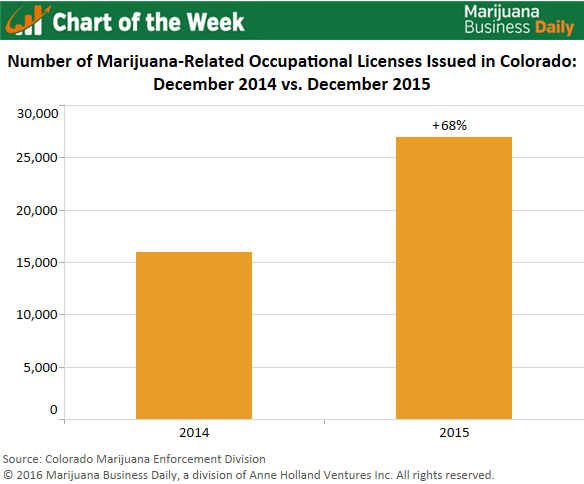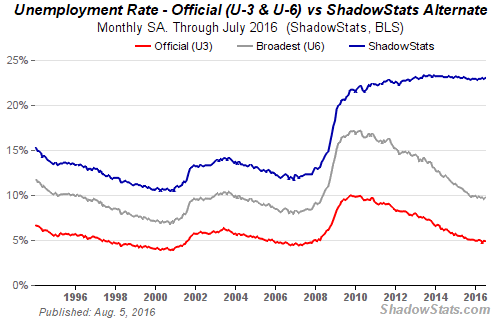The July numbers from the Labor Department's Bureau of Labor Statistics are out! There were 255,000 jobs added last month, and the unemployment rate remained at 4.9 percent! Whoohoo!!! Before you grab the champagne glasses, however, here's a look at how anticlimactic and skewed those numbers really are.
Thanks to the nature of bureaucratic statistics and the state's ability to remove data from their results by altering definitions of inputs, Uncle Sam can make an ominous situation look like something to celebrate.
The official unemployment rate is defined as "total unemployed, as a percent of the civilian labor force." Simple enough, right?
The "total unemployed," however, excludes a surplus of individuals, who are deliberately removed from the data to show bogus growth.
According to the BLS, to be counted in the total unemployed, or U3 data, an individual has to have looked for work actively within the four weeks prior to the unemployment survey. If the active search for work was in the last year, but not in the last four weeks, the individual is considered a “discouraged worker” by the BLS and is not included in the data.
Here is where the bureaucracy works its magic to keep you in the dark. Once a person moves from the 'official' total unemployed (U3) to the (U6) data range (all persons marginally attached to the labor force, plus total employed part time for economic reasons, as a percent of the civilian labor force plus all persons marginally attached to the labor force), they no longer matter.
Aside from simply counting heads, the U6 data set, or rather, the real number of unemployed Americans, is defined out of existence for political convenience.
When we look at real unemployment versus what the government tells the citizens, there is a staggering difference.
"John Williams’ Shadow Government Statistics" is an electronic newsletter service that exposes and analyzes flaws in current U.S. government economic data and reporting, as well as in certain private-sector numbers, and provides an assessment of underlying economic and financial conditions, net of financial-market and political hype.
According to the latest ShadowStats data, there is nearly a 20 percent difference in what the state says the unemployment rate is, versus what the real unemployment rate is.
In July, the nation’s civilian noninstitutional population, consisting of all people 16 or older who were not in the military or an institution, reached 253,620,000. Of those, 159,287,000 participated in the labor force by either holding a job or actively seeking one.
What that means is that a whopping 94,333,000 people remain without a job, and the US government and their lackeys in the mainstream, are somehow celebrating this.
The 255,000 jobs "created" in July that everyone is cheering about, accounts for only one-tenth of one percent of all unemployed people.
Let that sink in.
As if those numbers aren't worrisome enough, in its long-term budget outlook published in July, the Congressional Budget Office projected that the labor force participation rate will decline from about 63 percent in 2017 to around 58 percent in 2046.
Of course, this sounds like all doom and gloom. However, just because people aren't employed according to the government standards, does not mean they aren't thriving.
The market is responding to the declining job market with unusual and inspiring solutions for people to earn a living outside of filling a cubicle from nine to five.
When the government loosens its grip on the private lives of individuals, sustainable growth booms. Thanks to the legalization of both recreational and medicinal use of cannabis, Colorado is enjoying a tremendous economic boost. Sales from licensed stores totaled almost $1 billion last year, nearly equaling craft beer sales.
While it resulted in $135 million in taxes and fees for the state of Colorado, more importantly, it is proving to be a job engine -- which is the best form of economic stimulus. This chart demonstrates just how much job growth the cannabis industry is providing in Colorado.

And this chart doesn't account for the countless individuals who work on a cash basis -- outside of the government's tally.
On top of the thriving cannabis industry, entrepreneurs and web developers are building flourishing online economies in which people can make money without ever leaving their homes.
Steemit is one of those places. This uncensorable network is a blockchain-based social media platform where anyone can earn money. It works in a similar fashion to Reddit, however, instead of being banned or censored for posts, if other users like your content, you make money.
In a time where robots are replacing minimum wage workers in fast food chains, the outlook can tend to appear bleak -- and, it could very well be that way for a while. However, as long as humans are aware of their surrounds and resist the state's control and influence over their livelihoods, the possibilities are endless.
Matt Agorist is an honorably discharged veteran of the USMC and former intelligence operator directly tasked by the NSA. This prior experience gives him unique insight into the world of government corruption and the American police state. Agorist has been an independent journalist for over a decade and has been featured on mainstream networks around the world. Follow @MattAgorist

** WARNING ** Marijuana causes BRAIN DAMAGE if your age is under 25 !!
Downvoting a post can decrease pending rewards and make it less visible. Common reasons:
Submit
Downvoting a post can decrease pending rewards and make it less visible. Common reasons:
Submit